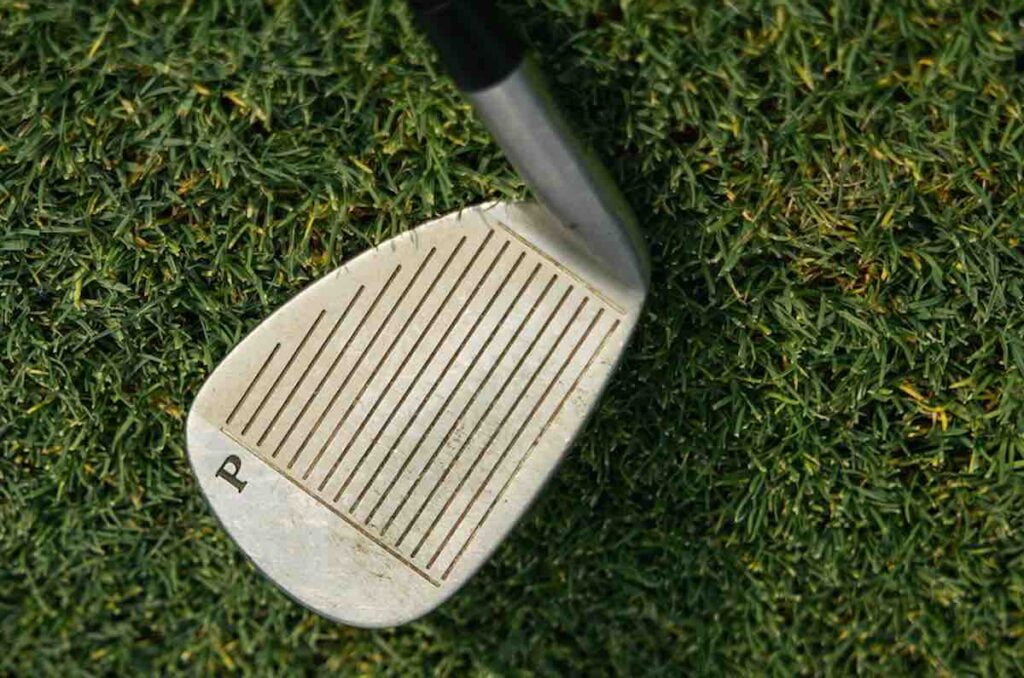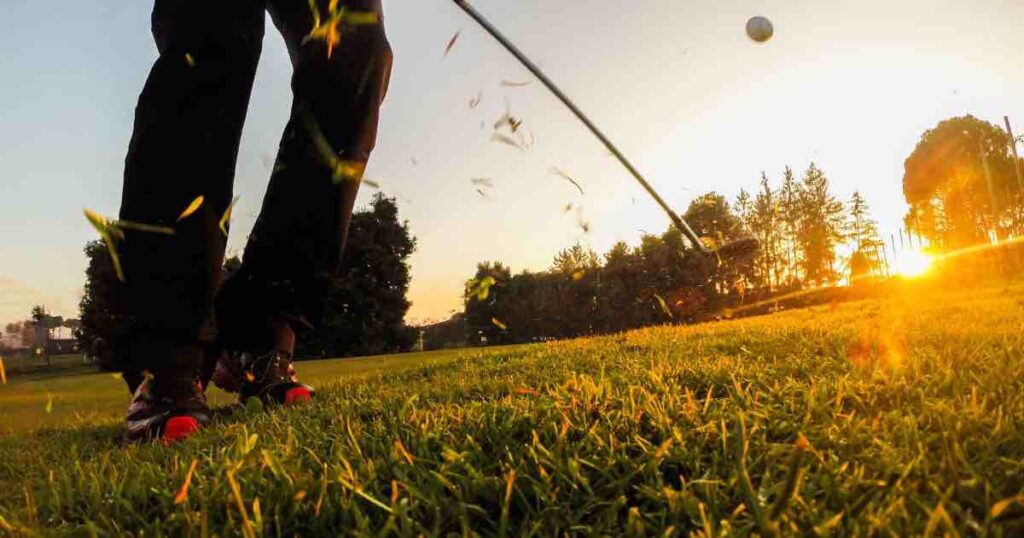Golf is a sport of precision. Which relies heavily on the condition of your equipment, especially your golf clubs. A clean golf club is not just about aesthetics: Regular maintenance and cleaning of your golf clubs are crucial to ensure their longevity and optimal performance. So, let’s discuss how to clean golf clubs properly. We’ll cover the importance of regular cleaning, the materials needed, and a step-by-step guide on how to clean golf clubs properly. We’ll also share some warnings to avoid while implementing an effective golf club cleaning routine.
Why You Should Clean Your Golf Clubs

Improved Performance
The grooves on a golf club are designed to create spin and control the ball’s trajectory. When these grooves are clogged with dirt or grass, it can significantly reduce the backspin applied by the club, affecting the ball’s flight and accuracy. A clean clubface provides better contact with the ball, leading to more consistent shots and improved overall performance. This is especially true of wedges, where spin and control are critical to the shot.
Longevity of Clubs
Investing in a set of golf clubs can be substantial, making it crucial to extend their lifespan as much as possible. Regular cleaning helps prevent rust and corrosion, maintaining the club’s integrity and ensuring they last longer.
Preventing Damage
Dirt and debris can affect more than just your shot performance. Over time, accumulated dirt can cause scratches and other physical damage to the clubface, especially when the club is stored without cleaning. These micro-abrasions can eventually lead to significant wear and tear, reducing the effectiveness of your clubs and shortening their lifespan.
Regularly cleaning your golf clubs is a simple yet effective habit that can significantly improve your game and protect your investment. It ensures that your clubs continue performing at their best, giving you the confidence to take any course with your best swing.
Materials Needed for Cleaning Golf Clubs
Cleaning your golf clubs doesn’t require specialized equipment; you can easily find most of the necessary items at home. Here’s a list of materials you’ll need to effectively clean your golf clubs:
- Warm Water: Warm water is better than cold water for loosening dirt and debris stuck in the grooves of your golf clubs.
- Dish Soap or Cleaning Solution: A mild dish soap or a specialized golf club cleaning solution can help dissolve grime and grease on your clubs. Avoid using harsh chemicals as they could potentially damage the finish of your clubs.
- Bucket: You’ll need a bucket large enough to soak your clubheads. This pre-soaking process helps soften and loosen the dirt, making it easier to remove.
- Soft-Bristled Brush or Toothbrush: A brush with soft bristles is ideal for cleaning your golf clubs without scratching them. An old toothbrush can also work well, especially for getting into the small grooves.
- Microfiber Cloth or Towel: After cleaning, you’ll need a soft towel or microfiber cloth in order to dry your clubs and prevent rusting. Microfiber is excellent because it absorbs water quickly and is gentle on the club’s surface.
By ensuring you have these materials on hand, you can keep your golf clubs in ideal condition, ready for every swing on the course.
How to Clean Golf Clubs
Cleaning your golf clubs involves a few simple steps that are easy to follow. Here’s a step-by-step guide on how to properly clean your golf clubs:
Pre-Cleaning Stage
The first step in cleaning your clubs is to prepare your cleaning solution. Fill a bucket or large plastic bowl with lukewarm water and add a small amount of dish soap or a mild cleaning solution. Then, submerge the heads of your dirty clubs into this soapy water, ensuring the water level doesn’t reach the ferrules (the joint between the clubhead and shaft). Let them soak for 5-10 minutes to loosen the dirt and debris.
Cleaning the Club Heads
After the pre-soaking stage, it’s time to clean the clubheads. Use a soft-bristled brush, or a old toothbrush perhaps, to gently scrub the clubheads and remove dirt from the grooves. Be sure to clean all surfaces, including the back and bottom of the clubhead. If your clubs have any stubborn dirt or grass stains, scrub a bit harder or let them soak a bit longer. Consider using a toothpick or a tee for stubborn dirt stuck in the grooves. They can reach into the grooves without causing damage.
Cleaning the Grips
Next, focus on the grips. These can be cleaned by dipping a brush in the warm, soapy water and scrubbing the grip thoroughly. After scrubbing, rinse the grip under running water to remove any soap residue. Avoid soaking the grips, as this can damage the material and reduce their lifespan.
Post-Cleaning Stage
Finally, after cleaning, it’s crucial to dry your clubs thoroughly to prevent rusting. Use a microfiber towel or any soft, absorbent cloth to dry each part of the club, including the clubhead, shaft, and grip. Ensure no moisture remains, especially in the clubhead grooves. Once dried, store your clubs in a cool, dry place away from direct sunlight.
Following these steps will ensure your golf clubs are well-maintained and ready to deliver optimum performance during your next round on the course.
Warnings for Golf Club Cleaning
While maintaining your golf clubs is essential to their longevity and performance, it’s important to do so correctly. Using the improper methods or materials can cause more harm than good. Here are some warnings to keep in mind:
- Avoid Harsh Brushes: Using brushes made of stainless steel or brass might seem like an effective way to remove stubborn dirt, but they can actually scratch and damage your clubs. Instead, opt for brushes with soft bristles, like nylon, which can effectively clean without causing harm.
- Don’t Soak the Grips: While cleaning the grips is important, soaking them in water can degrade the material and shorten their lifespan. Instead, scrub them with a brush dipped in warm, soapy water and rinse off the soap quickly.
- Avoid Harsh Chemicals: Some cleaning solutions and detergents can be too harsh for your clubs, potentially damaging the finish or even corroding the metal. Stick to mild soaps or specialized golf club cleaning solutions.
- Remember the Drying Process: Leaving your clubs wet after cleaning can lead to rusting, particularly on the clubheads. Always make sure to thoroughly dry your clubs after each cleaning session.
- Avoid Improper Storage: Storing your clubs in places with high humidity or extreme temperatures can cause damage over time. Make sure to keep your clubs in a cool, dry location.
By heeding these warnings, you can ensure that your golf clubs remain in excellent condition for many rounds to come.
FINAL THOUGHTS
Regularly cleaning your golf clubs is not just a matter of looking spotless—it’s essential to maintaining their performance and extending their lifespan. Dirt and debris can affect the club’s grip, balance, and the spin of the ball, all of which can impact your game. Furthermore, neglecting to clean your clubs can lead to rusting and other damage, shortening their useful life.
The steps outlined in this guide—pre-cleaning, cleaning the club heads and grips, and post-cleaning—are straightforward to incorporate into your golf routine. By investing a little time and effort, you can ensure that your clubs are always in top condition, ready to help you achieve your best performance on the course.
Thanks for reading our post on how to clean golf clubs. For more helpful insights visit our Golf Basics section.




